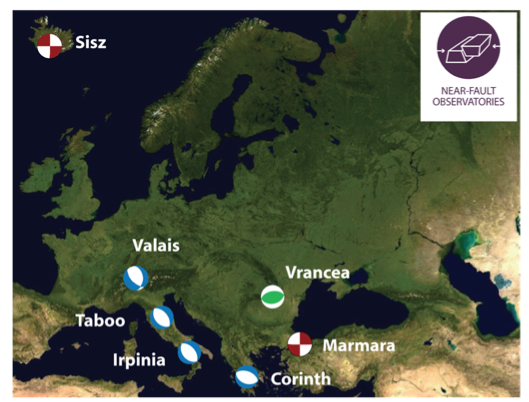The NFO community in EPOS

NFO is one of the EPOS Thematic Communities (TCS), consisting of seven NFOs operating on different tectonic regimes in Europe (see map) at sites of elevated seismic hazard.
The areas include plate boundary systems like South Iceland Seismic Zone (SISZ), Marmara Sea (MARMARA) and Corinth (CORINTH) rift. In mountain settings, NFOs monitor the Alto Tiberina (TABOO) and Irpinia (IRPINIA) faults in the Apenninic range, the Valais (VALAIS) region in the Alps, and the Vrancea (VRANCEA) fault in the Carpathian Mountains. They monitor diverse faulting mechanisms, high to very low angle faults, shallow and deep faults, as well as regions with fast (cm/yr) and slow (mm/yr) strain rate accumulation.
Each fault zone can generate large earthquakes (M>6) that pose substantial to great earthquake hazard. Two of the zones, Marmara Sea and Corinth, include off-shore seismic sources that pose an additional tsunami hazard while steep slopes and sediment-filled valleys in the Valais give rise to hazards from landslides and liquefaction. The active volcanoes flanking the South Iceland Seismic zone bring the added dimension of volcano-tectonic interaction and natural geothermal activity. The focus of the observatories varies, ranging from small- to large-scale seismicity and includes the role of different parameters, such as fluids, playing in fault initiation, the internal structure of fault systems, site effects and derived processes such as earthquake generated landslides and tsunamis. In response to their specific objectives, the NFO’s operate a diverse set of monitoring instrumentation to monitor the surface and sub-surface using seismic, deformation, strain, geochemical and electromagnetic equipment.
In response to their specific objectives, the NFOs operate diverse sets of monitoring instrumentation deployed at the surface and sub-surface, resulting in an exceptionally high degree of knowledge of the geometry and parameters characterizing the local geological structure and the deformation pattern.
What does EPOS gain from the NFOs?
NFOs represent a great scientific opportunity for major advancements in understanding fault systems. For EPOS, they constitute an ideal testbed for generating expertise on multidisciplinary data integration, creating tools for the next generation of multidisciplinary research, routine data analysis and data visualization. Due to their small size and focus, NFOs can drive innovation and development of cross-disciplinary services, standards and products that are important for other EPOS communities. The NFO community also facilitates knowledge transfer through sharing technological (best practice) and scientific know-how (transnational access), both within the NFOs themselves and across other communities.
We expect the NFOs will provide many opportunities for scientific and technical training as well as public outreach, at different levels: general education of the public on natural hazards and seismotectonic processes, higher education (summer schools, masters and postgraduate research) on advanced instrumentation techniques, multi-parameter analysis of crustal processes. Bringing together multidisciplinary data and expertise at a single site to be processed and integrated, will put important pieces in the puzzle of earthquake mechanics. Finally, besides the monitoring of the faults before the occurrence of main events, NFO dense networks can also improve operational actions conducted in the aftermath of a large earthquake, such as EEW and detailed, fast ground shaking and damage characterization during the on-going rupture on the fault.
NFOs constitute the ideal test beds for generating expertise on multidisciplinary data integration, creating tools for the next generation of multidisciplinary research, routine data analysis and data visualization. The processing of continuous and large data flow is expected to progress with time, in particular for the multi-sensor correlation analysis. These tools will evolve with the improved models of transient processes in/around fault zones. By working on the improvement of predictive models for future large earthquakes based on multi-parameter monitoring of diverse types of transients, NFOs help to better configure the next generation of the monitoring systems, and to provide interpretation and communication models for the authorities and public before, during and after the occurrence of a large event. Improved monitoring of active faults posing high hazard to the society, as well as progress in the knowledge of seismic faulting including inspection of different signals, will enhance our common capabilities to face and assess seismic hazard at different spatial and temporal scales. In this perspective, a new generation of near-real time tools and triggering alarms at different levels can be tested and developed strengthening the cooperation with the Agencies for risk management. A series of various actions like meetings of experts, simulated operations, including educational experiences for the population, can be also tested. Finally, besides the monitoring of the faults before-during-after the occurrence of seismic events, NFO develop innovative operational actions such as Early Warning Systems and detailed, fast ground shaking and damage characterization.
The NFO community facilitates knowledge transfer through sharing technological (best practice) and scientific know-how (transnational access), both within the NFOs themselves and across other Earth Science communities. It is projected that over the next decade, tens of such multi-disciplinary observatories will be installed in Europe, enabling substantial advances in our fundamental understanding of earthquake generation processes and associated ground shaking.
NFO Community Services
NFO community aggregated in EPOS provides trough FRIDGE its first set of web services for accessing raw data and scientific products, as a first attempt in support the more diverse stakeholder’s community constructing new research in Earth Science domain. NFOs meet the growing expectations of the learning and communication sectors by hosting a large variety of scientific information about earthquakes as a natural phenomenon and a societal issue, thus representing the EPOS concept and objective: aggregating and harmonizing the EU research infrastructures capabilities to facilitate broader scientific opportunity.
NFO community decided to benefit of the existing services for geodetic and seismic raw data repository and distribution. These data already possessing format and metadata recognised as standard by the community, are then distributed through the services organised and managed by the respective thematic communities.
NFO SEISMOLOGICAL RAW DATA - Continuous Velocimetric and Accelerometric waveforms, Stations information collected by all the NFOs, are available at the European Integrated Data Archive (EIDA) nodes with network codes labelled as NFO-NAME Virtual Networks. This allows to the user an easier and comprehensive way to discover and download the data.
NFO GEODETIC RAW DATA - Continuous Geodetic Data and Stations information are available at the European archive node (GLASS) built by the Geodetic community soon open.
NFO SPECIFIC DATA - All the remain raw data and high-level scientific data products not having yet a standard and a reference community (data we refer to as NFO Specific Data), are going to be managed at the NFO-TCS level, within the FRIDGE platform. The goal is having a unique and coordinated access. So far, we identified new standards for some Geochemical and Seismological time series, derived from the monitoring of diverse parameters (e.g. Radon, CO2 and Meteorological) and high resolution earthquakes catalogues (e.g. VP/VS).
TESTING FACILITY - NFOs community is developing a testing facility named CREW (EU TESTING CENTRE FOR EARLY WARNING & SOURCE CHARACTERIZATION) to compare methodologies and software for real-time monitoring of faulting processes. Today, CREW is operational in real-time mode for Earthquake Early Warning (EEW). CREW receives real-time data from NFOs to feed the EEW software. When an earthquake occurs, the systems provide alerts, which are codified in QUAKEML strings; information is then combined with catalogues from authoritative bulletins to provide performance statistics, actually based on correctness of location and magnitude and promptness of the alert, from origin time or first pick. A web interface will provide the statistics about software performances. The system will also work offline on certified databases, using a playback procedure, whose earthquake parameters can be downloaded by the user, offering the possibility to download data and upload results, thus comparing software.
TRAINING NETWORK ACTIVITY - NFOs will soon offer the possibility to host state-of-the-art experiments for testing in situ both new scientific ideas/models and new geophysical instruments or arrays. The NFO will provide the proper environment in terms of reference instruments, data and infrastructures facilities. NFOs are also entirely qualified as a network for transnational Education and Training. The NFO will provide many opportunities for scientific and technical training as well as public outreach, at different levels.

